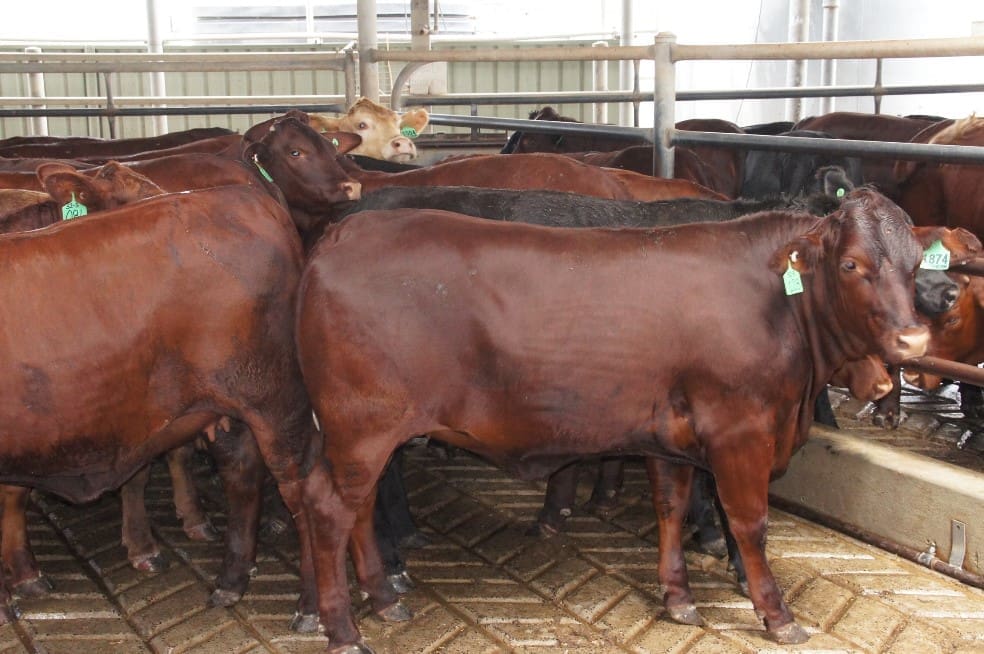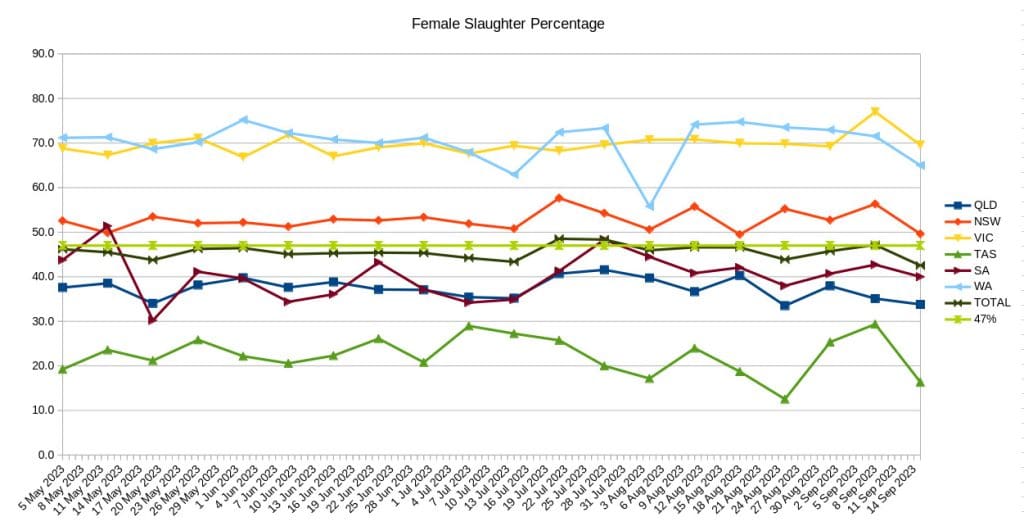WHILE the proportion of female cattle involved in national slaughter has been on the rise as seasonal conditions have worsened across eastern Australia this year, there’s also evidence of dramatic variation from one state to another.
The extent of female kill is typically presented as the Female Slaughter Ratio (FSR) – the percentage of female-to-male adult cattle in each week’s national kill.
A figure of 47pc is frequently quoted as the ‘tipping point’ between herd expansion and contraction, on a national basis.
Long term, the Australian FSR quarterly average since records began in 1976 is in fact 47.6pc. This suggests that a national FSR at 47pc is simply the long-term average female kill rate, rather than the scientific tipping-point between liquidation and rebuild.
The weekly FSR figure for national slaughter as reported in NLRS weekly statistics has crept past 47pc a number of times since July, signalling female liquidation due to poor pasture conditions and little immediate prospect of rain may be starting.
In contrast, this week last year (week ending 30 September 2022), the national female kill ratio was back at just 40.2pc.
Some stakeholders suggest the use of 47pc as the national ‘tipping point’ is in fact too high. They say it does not take into account the paddock losses of breeding females (much longer-term paddock residents than steers) due to snake bite, dystocia, misadventure, or other factors.
The United States beef industry also uses 47pc as its indicator of breeding herd contraction/expansion.
But unlike Australia, which delivered entire quarters during its 2019 drought with an FSR above 58pc, the US industry never exceeded 54pc during its own extreme drought last year. Feedlot resources (both infrastructure and commodities) may have played a part in that.
Australia’s national FSR for the full calendar drought year 2019 averaged 56pc, the highest on record since statistics began in 1976.
Incredibly wide divergence among states
However as the graph above generated by a Beef Central reader last week shows, there is enormous variation from state-by state in female kill.
The graph statistics above (plotting the period since May this year) are based on NLRS weekly slaughter reporting data, which it must be said, is a voluntary process, with some processors (representing an estimated 10-15pc of capacity) choosing not to contribute.

MSA heifers being prepared for processing at Oakey Beef on the Darling Downs
In the graph, states like Victoria and Western Australia show surprisingly high rates of female kill, at (give or take) 70pc, while at the other end of the scale, Tasmania sits at a figure close to 20pc.
It means that the ‘trigger point’ signalling herd rebuilding or herd contraction varies sharply from state to state.
There are some well-known reasons for why some states are higher (or lower) than others for FSR, but others are more obscure.
In Tasmania (apple green line, + or – 20pc FSR), large numbers of cull females, both beef and dairy, are shipped across the Tasman to Victoria for slaughter, pushing Tasmania’s gender pendulum towards the ‘male’ side.
In Western Australia (light blue line, + or – 70pc) live export out of northern regions is skewed towards steers, while there is also some migration of feeder steers into feedlots in South Australia and elsewhere (see references to more WA steer purchases by SA lotfeeders in this earlier article.) In a state with a relatively small slaughter cattle population, dairy females also play a part in WA kill statistics.
Queensland (dark blue line, less than 40pc FSR) and New South Wales (red line, well above 50pc FSR) figures tend to be influenced by the large trade in NSW-bred feeder steers heading north into Queensland’s large feedlots, and the trade in cull cows out of Queensland heading south for slaughter.
Is NSW the ‘goldilocks’ state?
Some stakeholders suggest that due to the wide variance in female kill between states, the middle-ground NSW ‘goldilocks’ figure perhaps provides the best overall industry trend indictor. The data says on a quarterly basis there is a spread of 2.3pc between NSW and the national SFR figure. This is the tightest of all the states, attracting some to use NSW as the key barometer of the national picture on cow kill.
Still others use a formula based on a combination of NSW and Queensland kills, to try to iron-out some of the static.
Third quarter ABS stats may tell the story
While ABS statistics suggested that second quarter (ended June 30) female kill in Australia reached 48pc (up from about 43pc for the March quarter), Meat & Livestock Australia has been reluctant to ‘call’ the current cycle as a sign of herd liquidation, saying it wants to wait until more data becomes available.
Weekly NLRS kill statistics is voluntary-only, so MLA is waiting for the September quarter ABS kill data to gauge the longer-term impact – somewhat similar to an ‘official’ economic recession being based on two consecutive quarters of negative economic growth.
MLA correctly points out that other factors in fact may influence a rise in female kill.
The current sharp increase in Australia’s beef exports (volume as well as price) to the United States is a case in point. A large proportion of our exports to the US are made up of lean manufacturing beef for hamburgers, mostly produced from cows.
That may positively influence prices for slaughter females, relative to other cattle, prompting decisions to sell more females to processors.
But a second consecutive quarter of ABS national female slaughter above 47pc would present a compelling case that herd liquidation has now started, at least across large parts of eastern Australia.
Stand by for an ABS quarterly stats release around mid-November, to learn more.
Further reading:
Female slaughter ratio points to return to beef herd liquidation
MLA analyst (now NLRS manager) Ripley Atkinson wrote this discussion paper about female slaughter ratio earlier this year.

